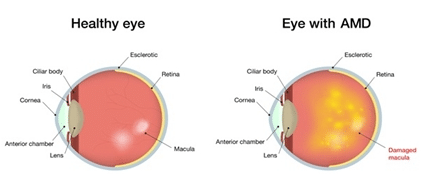Six Things You Should Know About AMD


AMD (Age-related macular degeneration) is the leading cause of blindness among older Americans, but new treatments and protective steps can help people with AMD avoid vision loss. You should know about AMD, its risk factors and treatment options. Here are the six things I think everyone should know about the condition:
1. There may be no early symptoms.
AMD may not have noticeable symptoms during the early stages, but early diagnosis allows for timely treatment and careful monitoring of the progression of the disease. Although symptoms, in some cases, symptoms may be present, the best line of defense is to get a comprehensive eye exam, even if you don’t need glasses or contact lenses. The American Academy of Ophthalmology recommends adults with no symptoms have an eye exam at least by age 40, and every one-to-two years after age 65.
2. Treatments are now better than ever.
A decade ago, there was little that could be done to stop the most advanced form of AMD (“wet” AMD) from stealing people’s vision. Today, due to huge advances in treatment, such as the use of anti-VEGF drugs, fewer people are going blind due to AMD.
3. Vitamins can help slow AMD (but not in all cases).
If you have AMD, you may have heard that a specific vitamin formula can help slow progression of the disease. Clinical trials have shown that two formulas (known as the AREDS and AREDS2 formulas), which are high in antioxidants and zinc, can be good in people with intermediate AMD or advanced AMD in only one eye. They have not been shown to prevent AMD in people who do not have the disease.
4. Smoking increases risk.
Numerous studies have found that smoking can increase risk of AMD as well as the speed at which the disease progresses. Smoking cessation is the best action you can take to lower your risk of AMD. If you already kicked the habit, you’ll be happy to know that those who quit smoking 20 years ago have the same risk of AMD as people who have never smoked.
5. Daily vision monitoring at home can help.
The Amsler grid is a simple chart that people with dry AMD can use at home to monitor progression of the disease. All you have to do is look at it once every day! Learn how to use the Amsler grid and do this on a regular basis to help track progression and risk of AMD-related vision loss.
6. Eating certain foods may reduce AMD risk.
Studies have shown that foods rich in omega-3 fatty acids are good for eye health and are associated with reduced risk of AMD — but not when taken as supplements. You may also consider adding some other nutrients that benefit your eye health, such as lutein and zeaxanthin, zinc and vitamin C. Which foods contain these nutrients? Citrus fruits, kale, spinach, corn, broccoli, squash, cold-water fish (such as salmon and tuna) and black-eyed peas are a a few to start with.
While there is little that can be done to improve the eyesight of someone who has AMD, with early detection, the rate of vision loss can be slowed. The keys to slowing vision loss are to understand macular degeneration, monitor your symptoms and visit your ophthalmologist regularly to test your vision.
